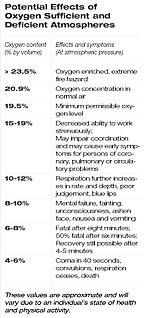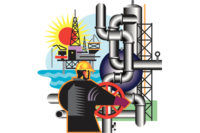What is a confined space?
The confined space entry standard was established by OSHA 29CFR 1910.146 in April 1993. The standard was developed to provide a defined work plan for confined space entry. Confined space entries are part of a daily routine throughout the industrial workplace.A confined space is defined as a space that:
- Is large enough for an employee to enter and perform work.
- Has limited or restricted means for entry or exit.
- Is not designed for continuous human occupancy.
A permit-required confined space is defined as a confined space, plus one of the following:
- Contains, or has a known potential to contain, a hazardous atmosphere.
- Contains material with the potential for engulfment.
- Has an internal design that could entrap or asphyxiate the entrant.
- Contains any recognized safety or health hazard.
Atmospheric hazards
Atmospheric hazards found in a confined space are those that expose entrants to a risk such as death, entrapment, injury or acute illness from one or more of the following causes:
- The lowest concentration (air-fuel mixture) at which a gas can ignite is called Lower Explosive Limit (LEL). Concentrations below this limit are too lean to burn.
- The highest concentration that can be ignited is its Upper Explosive Limit (UEL). Above that concentration, the mixture is too rich to burn.

Monitoring confined spaces
Monitoring the air inside a confined space is required prior to entering. Testing a confined space for atmospheric hazards should be done remotely before entering, and should be done in this order:1) Ensure that proper oxygen levels are present.
2) Ensure that combustible gases are not present.
3) Ensure that toxic gases are below the OSHA permissible exposure limit. Common toxic gases in a confined space could be hydrogen sulfide (H2S) and carbon monoxide (CO), but other toxic compounds could be present.
Monitors can be used to evaluate all these gases either individually or simultaneously.
In a confined space it is important to take samples at the top, middle and bottom to locate varying concentrations of gases and vapors. There are some gases lighter than air (e.g., methane and other combustible gases) that can be found at the top of a confined space. There are other gases that are heavier than air (e.g., hydrogen sulfide) that can settle near the bottom of a confined space, and still other gases that are the same weight as air (e.g., carbon monoxide) that can be found throughout a confined space.
Take air samples at several levels within the confined space and continuously monitor the space due to the fact that conditions can change.
As the remote air monitoring is completed and the area is safe for entry, confined space entry permits should be completed and followed. After the initial entry, monitoring the air in the confined space should be continuous. A confined space entry attendant or hole watch should carry out the continuous monitoring. Conditions in a confined space can change without warning, due to leakage, toxic vapor release or disturbing the contents of the space.
Article adapted from RAE Systems’ Application Note AP-206, “Guide to Atmospheric Testing in a Confined Space.†This application note contains only a general description of atmospheric testing in a confined space and equipment used to monitor a confined space. Under no circumstances should a confined space be entered or monitoring equipment used except by qualified and trained personnel, and after all instructions have been carefully read and understood and all precautions followed.
RAE Systems Inc., 1339 Moffett Park Drive, Sunnyvale, CA 94089, (408) 752-0723, www.raesystems.com; raesales@raesystems.com
SIDEBAR: Examples of a confined space:
- Storage tanks and vessels
- Sewers and manholes
- Underground utility vaults
- Agriculture silos
- Railcar tanks
- Marine vessel tanks
- Tunnels
- Grain elevators




